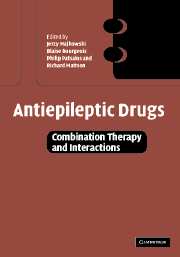Book contents
- Frontmatter
- Contents
- List of contributors
- Foreword
- Foreword
- Acknowledgements
- Part I Introduction
- Part II Pharmacokinetic interactions
- 4 Pharmacokinetic principles and mechanisms of drug interactions
- 5 Predictability of metabolic antiepileptic drug interactions
- 6 Influence of food and drugs on the bioavailability of antiepileptic drugs
- 7 Interactions between antiepileptic drugs
- 8 Interactions between antiepileptic and non-antiepileptic drugs
- Part III Pharmacodynamic interactions
- Part IV Drug interactions in specific patient populations and special conditions
- Part V Conclusions and future perspectives
- Index
4 - Pharmacokinetic principles and mechanisms of drug interactions
from Part II - Pharmacokinetic interactions
Published online by Cambridge University Press: 07 September 2009
- Frontmatter
- Contents
- List of contributors
- Foreword
- Foreword
- Acknowledgements
- Part I Introduction
- Part II Pharmacokinetic interactions
- 4 Pharmacokinetic principles and mechanisms of drug interactions
- 5 Predictability of metabolic antiepileptic drug interactions
- 6 Influence of food and drugs on the bioavailability of antiepileptic drugs
- 7 Interactions between antiepileptic drugs
- 8 Interactions between antiepileptic and non-antiepileptic drugs
- Part III Pharmacodynamic interactions
- Part IV Drug interactions in specific patient populations and special conditions
- Part V Conclusions and future perspectives
- Index
Summary
Introduction
In recent years, many of the fundamental principles and concepts of pharmacokinetics have emerged from studies with antiepileptic drugs (AEDs). Pharmacokinetics describes how a drug is absorbed, distributed, metabolized, and ultimately excreted from the body. These characteristics will determine not only the ease of clinical use of the drug (e.g. how it is prescribed) and whether or not a patient will comply with its prescription, but also the pharmacokinetics of a drug has a direct impact on a drug's efficacy. During combination therapy with AEDs and indeed with AEDs and other drugs, there is potential for interference in pharmacokinetic processes and these interactions can be of major clinical significance. In this chapter, we review the various pharmacokinetic principles that are important to drug interactions and relate these to the major mechanisms of drug interactions.
Mechanisms of drug interactions
There are two basic types of drug interaction, pharmacokinetic and pharmacodynamic. Pharmacokinetic interactions are associated with changes in drug disposition, which are readily measured in that changes in drug concentrations in plasma occur. These interactions, which in fact can be associated with a change in plasma concentration of either the drug or its metabolite(s) or both, involve a change in the absorption, distribution, or elimination of the affected drug and account for most known interactions (Patsalos and Perucca, 2003a). Pharmacodynamic interactions are also important but are less well recognized and occur between drugs that have similar or opposing pharmacological mechanisms of action.
Keywords
- Type
- Chapter
- Information
- Antiepileptic DrugsCombination Therapy and Interactions, pp. 47 - 56Publisher: Cambridge University PressPrint publication year: 2005



